Most of us worry about things like breast cancer, thinking that all that fundraising and pink ribbons must mean it’s one of women’s biggest risks. But you know what? Lung cancer kills more women than breast cancer. Even scarier, it’s not cancer that is the most likely thing to kill women, it’s common old heart disease.
Health risk #1: heart disease
Cardiovascular disease may be more associated with older males, but women are 10% more likely than men to have it. About one-third of all deaths in New Zealand are from some form of cardiovascular disease, which is actually diseased blood vessels blocking blood supply to the heart, brain or legs. In New Zealand, heart attack rates are falling and survival rates are rising, but it’s still our biggest killer. How can you avoid it? Don’t smoke, and maintain a healthy weight and cholesterol levels with regular exercise and a healthy diet.
Health risk #2: stroke
Stroke is not only a big killer, but can leave women horribly disabled and unable to care for their families. Stroke, a feature of cerebrovascular disease, involves the blood vessels supplying the brain and its membranes and accounts for 8% of all deaths, mostly in older women. Stroke occurs when there is bleeding or a blockage to a blood vessel to the brain and it can lead to death or brain damage, paralysis and speech problems.
Health risk #3: dementia
None of us want to go ga-ga in our old age, but dementia is extremely common in older women over the age of 60. It is a deterioration of brain function, including memory, understanding and reasoning and dementia is the umbrella name for a variety of diseases, most commonly Alzheimer’s. There is no prevention or cure, but keeping your brain and social life active is thought to help, as is eating a diet rich in antioxidants, leafy greens and oily fish.
Health risk #4: lung cancer
Statistically speaking, by the time a woman is 85, one-third of all women will have been diagnosed with some kind of cancer. Lung cancer is only the fifth most common cancer but it claims the most lives. Incidence and death rates are growing among women, reflecting the rise in female smokers over the past decades. 90% of cases are caused by active or passive smoking. Exposure to industrial substances such as asbestos can also be a risk factor.
Health risk #5: breast cancer
Breast cancer is the most common cancer in women but improvements in detection and treatment have helped death rates fall by 27% in the past decade. Today, a woman in her 60’s has a 1 in 33 chance of developing breast cancer in the next 10 years. The average age of diagnosis is 60, but it is still the most common cause of death among women aged 25 to 64.You are at greater risk if you have a family history of the disease. Research has shown lifestyle plays a big role in your likelihood of breast cancer, with inactivity, weight gain, alcohol intake, using the contraceptive pill and taking hormone replacement therapy over a long period being risk factors.
Health risk #6: chronic obstructive pulmonary disease
Chronic obstructive pulmonary disease is a wordy name to describe a range of respiratory conditions like emphysema and chronic bronchitis. The lung is damaged and airways become obstructed, making it difficult to breathe. Three-quarters of deaths from this respiratory condition are attributed to having smoked, while other causes include respiratory infections, air pollution and occupational dusts and chemicals.
Health risk #7: influenza
Who would have thought flu was so likely to kill us? This common viral respiratory infection is more than a bad cold, especially for women as they age. It’s not just the high fevers caused by flu that are a problem, but it can lead to pneumonia and inflammation of the brain or heart. While not the most common infectious disease, it is the most fatal, especially if you are over 65 or in a high-risk group such as being a pregnant woman, or you have an underlying medical condition such as HIV or cancer. Flu epidemics occur, on average, every three years, and pandemics much less regularly. Annual immunisation is advisable for those at risk.
Health risk #8: diabetes
Diabetes mellitus is a condition where the body can’t maintain blood glucose levels. There are three types, type 1, type 2 and gestational, but type 2 is the most common. If undetected or poorly controlled, diabetes can lead to blindness, kidney failure, lower limb amputation, heart attacks and strokes. As women get older, it’s important to have a diabetes risk assessment to see if you need a blood glucose test. Obesity, old age, a history of CVD, polycystic ovary syndrome and genetics all increase the risk of contracting diabetes.
Health risk #9: colorectal cancer
Commonly called bowel cancer, this is the second most common cancer in women, who have a one in 15 chance of being diagnosed by age 85. Old age, inflammatory bowel disease, obesity and smoking are risk factors. Screening is recommended from age 55. Diet and exercise may prevent up to 75 per cent of cases.
Health risk #10: chronic kidney disease
Kidneys are a bigger problem than most of us imagine. This condition occurs when the kidney is so damaged it may require kidney replacement therapy — dialysis or a transplant. If left untreated, end-stage kidney disease can kill in weeks. Women with diabetes, high blood pressure, glomerulonephritis (inflammation of the kidney’s small blood vessels), urinary tract infections tend to be more at risk. Age, genetics, inactivity and smoking also play a part. To fight chronic kidney disease, eat healthily, exercise, monitor your blood pressure and keep your diabetes under control.






Hmmmm definitely worth thinking about – I try and eat healthy (organic where possible) and exercise, however I do have hip dysplasia so exercising is difficult although I walk to and from work every day. I did have a full blood test done a few months back and my “bad” cholesterol level was slightly elevated, the Doc didn’t seem too concerned so I’ll just cut back on full fat milk and real butter 🙂